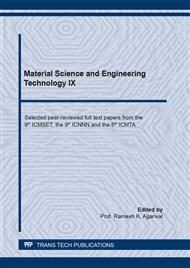[1]
A. Gupta, M. Kowalczuk, W. Heaselgrave, S. Britland, C. Martin and I. Radecka. The production and application of hydrogels for wound management: A review. European Polymer Journal. Vol. 111, 134-151, (2019).
DOI: 10.1016/j.eurpolymj.2018.12.019
Google Scholar
[2]
S. Mohd, M. Abdullah and K. Mat Amin. Gellan gum/clay hydrogels for tissue engineering application: Mechanical, thermal behavior, cell viability, and antibacterial properties. Journal of Bioactive and Compatible Polymers. Vol. 31, 648-666, (2016).
DOI: 10.1177/0883911516643106
Google Scholar
[3]
K. Mat Amin et al. Polyelectrolyte Complex Materials Consisting of Antibacterial and Cell-Supporting Layers, Macromolecular Bioscience. Vol. 12, 374-382, (2011).
DOI: 10.1002/mabi.201100317
Google Scholar
[4]
K. Zia, M. Zuber, M. Barikani, R. Hussain, T. Jamil and S. Anjum. Cytotoxicity and mechanical behavior of chitin–bentonite clay based polyurethane bio-nanocomposites. International Journal of Biological Macromolecules. Vol. 49, 1131-1136, (2011).
DOI: 10.1016/j.ijbiomac.2011.09.010
Google Scholar
[5]
S. Murugesan and T. Scheibel, Copolymer/Clay Nanocomposites for Biomedical Applications. Advanced Functional Materials. Vol. 30, 1908101, (2020).
DOI: 10.1002/adfm.201908101
Google Scholar
[6]
K. Galos. Composition and ceramic properties of ball clays for porcelain stoneware tiles manufacture in Poland, Applied Clay Science. Vol. 51, 74-85, (2011).
DOI: 10.1016/j.clay.2010.11.004
Google Scholar
[7]
M. Auta and B. Hameed. Chitosan–clay composite as highly effective and low-cost adsorbent for batch and fixed-bed adsorption of methylene blue. Chemical Engineering Journal. Vol. 237, 352-361, (2014).
DOI: 10.1016/j.cej.2013.09.066
Google Scholar
[8]
S. Shehata, R. Shalaby, M. Ismail, M. Abouheba and A. Elrouby. Staged laparoscopic traction-orchiopexy for intraabdominal testis (Shehata technique). Journal of Pediatric Surgery, Vol. 51, 211-215, (2016).
DOI: 10.1016/j.jpedsurg.2015.10.063
Google Scholar
[9]
M. Bonifacio, P. Gentile, A. Ferreira, S. Cometa and E. De Giglio. Insight into halloysite nanotubes-loaded gellan gum hydrogels for soft tissue engineering applications. Carbohydrate Polymers. Vol. 163, 280-291, (2017).
DOI: 10.1016/j.carbpol.2017.01.064
Google Scholar
[10]
S. Mohd, M. Abdullah and K. A. Mat Amin, Gellan gum/clay hydrogels for tissue engineering application: Mechanical, thermal behavior, cell viability, and antibacterial properties. Journal of Bioactive and Compatible Polymers, Vol. 31, 648-666, (2016).
DOI: 10.1177/0883911516643106
Google Scholar
[11]
P. Wu, A. Fisher, P. Foo, D. Queen and J. Gaylor. In vitro assessment of water vapour transmission of synthetic wound dressings. Biomaterials, Vol. 16, 171-175, (1995).
DOI: 10.1016/0142-9612(95)92114-l
Google Scholar
[12]
M. Sirousazar, M. Kokabi, Z. Hassan and A. Bahramian. Polyvinyl Alcohol/Na-Montmorillonite Nanocomposite Hydrogels Prepared by Freezing–Thawing Method: Structural, Mechanical, Thermal, and Swelling Properties. Journal of Macromolecular Science. Vol. 51, 1335-1350, (2012).
DOI: 10.1080/00222348.2011.629870
Google Scholar


